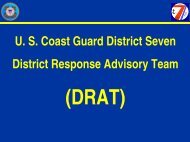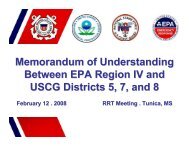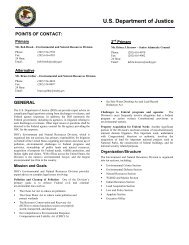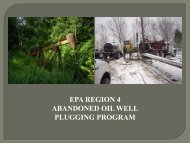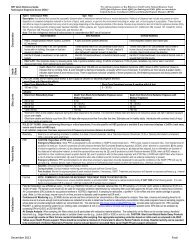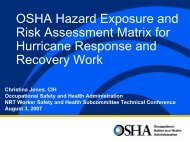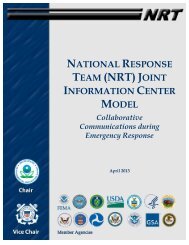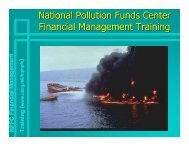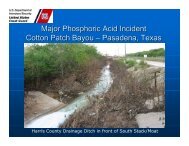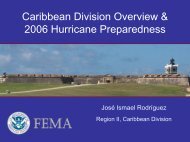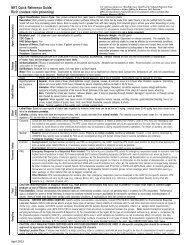mile from any reef which is less than 20 feet from the water’s surface, and where the water depth in the applicationarea is greater than 60 feet.Dispersants are not pre-authorized for use in, on, or over waters containing reefs, waters designated as marinereserves, mangrove areas, fresh or brackish waters or waters in coastal wetlands; except with the prior and expressconcurrence of the U.S. Virgin Islands Department of Planning and Natural Resources and <strong>USE</strong>PA, in consultationwith USDOC and USDOI. Coastal wetlands include: submerged algal beds (rocky or unconsolidated bottom),submerged seagrass beds, and coral reefs.Description of Oil DispersantsChemical dispersants are products applied to oil on the water surface to enhance formation of fine oil droplets, whichenter the water column and are dispersed by currents. Some physical dispersion occurs naturally following oil spillsdue to agitation created by wave action and ocean turbulence. Chemical dispersants enhance and accelerate thisnatural process, accomplishing in minutes to hours what otherwise requires days to weeks. The advantages of rapiddispersion early in a spill include minimizing direct contact of wildlife with a surface slick and reducing the amountof oil impacting sensitive nearshore and shoreline areas. Whereas untreated oil floating on the water surface can bebeached by wind, dispersed oil droplets are unlikely to strand ashore because they are not subject to wind action.Movement of dispersed oil droplets is determined by currents that do not penetrate the beach face.Dispersants, which are typically applied from vessel or aircraft mounted spray systems, offer several operationaladvantages. Dispersant application enables treatment of large areas of spilled oil much more quickly than can beaccomplished with mechanical methods and prior to significant expansion of the slick with time. Dispersants can beapplied in rough weather and sea conditions under which use of booms, skimmers, and other mechanical equipmentmay be impractical. To be effective, however, dispersants generally must be applied within the first few hoursfollowing an oil spill. This is a result of the fact that when oil is released to the marine environment it isimmediately subject to a wide variety of weathering processes. Weathering quickly increases the viscosity of the oil,making dispersion by the addition of chemical dispersants difficult if not impossible over time. Depending on thetype of oil spilled and the environmental conditions, the window of opportunity for successful use of dispersants canbe as short as a few hours.The key components of chemical dispersants are one or more surface-active agents, or surfactants. Surfactantscontain molecules with both water-compatible (hydrophilic) and oil-compatible (lipophilic or hydrophobic) groups.The surfactant molecules reduce the oil/water interfacial surface tension, enabling the oil layer to be broken into finedroplets with minimal mixing energy, thereby enhancing natural dispersion. Surfactants also tend to preventcoalescence of oil droplets and reduce adherence to solid particles and surfaces, such as sediments and feathers. Inaddition to surfactants, most dispersant formulations also contain a solvent carrier to reduce viscosity of thesurfactant so that the dispersant can be sprayed uniformly. The solvent may also enhance mixing and penetration ofthe surfactant into more viscous oils. Though early dispersants contained agents highly toxic to marine life,manufacturers have refined formulations of more recent generations of dispersants to dramatically reduce toxicity.Modern dispersants contain solvents composed of nonaromatic hydrocarbons or water-miscible concentrates(alcohols or glycols) as well as less toxic surfactants. The exact dispersant-to-oil application ratio, usually plannedat 1:10, is determined by the nature of the oil and sea conditions.By dispersing oil into the water column, the spreading or dilution becomes three-dimensional. The subsurface oilconcentration initially increases, but diminishes rapidly with distance and time due to physical transport processes.This is in contrast to untreated oil concentrated at the water surface, which can coalesce in surface convergencezones even after it has spread out to very low concentrations. The highest concentration of chemically dispersed oiltypically occurs in the top meter of water during the first hour following treatment (Rycroft et. al., 1994). Availabledata suggest that concentrations of more than ten parts per million (ppm) of dispersed oil are unlikely beyond tenmeters (depth) of the slick and that even within one meter depth of the slick, concentrations rarely exceed 100 ppm.The continuous mixing and dilution capabilities of open water lead to uniformity and are sufficient to rapidly reducethese concentrations. Field studies show that water column concentrations decline to undetectable or backgroundlevels within several hours following application of a dispersant (SEA, 1995). Under untreated slicks, oilconcentrations typically range from a few parts per million to less than 0.1 ppm, diminishing with depth and time.
The dispersed oil droplets, ranging in size from microns to a few millimeters, break down by natural processes, suchas biodegradation. Microbial biodegradation of oil appears to be enhanced by dispersal because of the larger surfacearea available as compared to a surface slick. Dispersants also prevent formation of tarballs and oil-in-wateremulsions (mousse), which tend to be resistant to biodegradation due to their low surface area. The chemicaldispersants applied, like the oil droplets, are diluted by diffusion and convective mixing. Much of the solventfraction evaporates immediately after the dispersing is applied. The surfactants are readily biodegraded.CetaceansDescription of Listed Species PresentEndangered cetaceans that occur in the area under considerations include two mysticete species: humpback, andfinback whales, and one odontocete, the sperm whale. Humpback whales (Megaptera novaeangliae) occur in thearea most commonly during their winter breeding season. Krill and small schooling fishes are the mainstay of thehumpback's diet. Finback whales (Balaenoptera physalus) winter in the area, primarily in offshore waters, and feedon small schooling fishes, pelagic crustaceans, and squid (NMFS, 1989). Both baleen whale species are allopportunistic feeders and may feed at or near the surface (McKenzie and Nicolas, 1988).The sperm whale (Physeter macrocephalus) occurs most frequently at the edge of the continental shelf or in deepoceanic waters. Sperm whales tend to inhabit areas with a water depth of 600 meters or more and are uncommon inwaters less than 300 meters deep. Sperm whales are deep diving and feed primarily on squid and deep water fishes.Sea TurtlesFour listed sea turtle species occur in the area under consideration. Leatherback, and hawksbill sea turtles areendangered; green and loggerhead sea turtles are threatened. Leatherback sea turtles (Dermochelys coriacea)nesting in the U.S. Caribbean is reported in the Virgin Islands (St. Croix, St. Thomas, St. John) and Puerto Rico,including Islas Culebra, Vieques, and Mona (NMFS and USFWS, 1992). Leatherbacks are considered to be a highlypelagic species but occasionally enter the shallow coastal waters of bays and estuaries. They may concentrate nearand follow drifting schools of jellyfish, their primary prey. Hawksbill sea turtles (Eretmochelys imbricata) arepredominantly tropical. Adult hawksbills characteristically inhabit shallow rocky areas and coral reefs but alsooccur in mangrove-bordered bays, estuaries, and lagoons and occasionally in deep waters. Juveniles occupy thedeeper water pelagic environment, often associated with floating patches of sargassum mats. Hawksbill turtles areomnivorous opportunists and seem to prefer invertebrates, particularly sponges (Ernst et al., 1994). Atlantic greensea turtles (Chelonia mydas) inhabit and nest in the U.S. Virgin Islands and Puerto Rico. Their preferred habitatappears to be lagoons and shoals with an abundance of marine grasses. Adult green sea turtles are primarilyherbivorous, foraging on algae and seagrasses; juveniles may eat a variety of invertebrates as well (NMFS andUSFWS, 1991a). Loggerhead turtles (Caretta caretta) wander widely throughout the marine waters of their range,including the area under consideration. They commonly inhabit the continental shelves and estuarine environments,occurring most frequently in waters less than 50 meters deep (Ernst et al., 1994). Hatchlings and juveniles are oftenfound along current fronts, downswells, or eddies associated with drifting mats of sargassum. Loggerheads areomnivores and feed on a wide variety of benthic invertebrates including crustaceans, mollusks, and sponges (NMFSand USFWS, 1991b).CetaceansEffects of Oil Spills on Listed SpeciesCetaceans spend considerable time at the surface swimming, breathing, feeding, or resting and so are at risk ofexposure to a surface oil slick, water-in-oil emulsion, or tar balls. Although there is evidence that some cetaceanspecies are able to detect oil, they do not always avoid it. The volatile fraction of crude oil contains many toxichydrocarbons that evaporate and can create hazardous air concentrations in the vicinity of a spill (Allen and Ferek,1993). The most serious potential risk to cetaceans appears to be inhalation of these toxic vapors, which can causeinflammation of mucous membranes of the eyes and airways, lung congestion, and possibly pneumonia. At very
- Page 2 and 3: UPDATES AND CHANGESCHANGE OR UPDATE
- Page 6 and 7: CARIBBEAN REGIONAL RESPONSE TEAMPOL
- Page 9 and 10: SECTION IPurposeThis policy provide
- Page 11 and 12: 2. YELLOW ZONE - WATERS REQUIRING C
- Page 13 and 14: SECTION IIIProtocolsTHE FOLLOWING R
- Page 15 and 16: APPENDICES
- Page 17 and 18: Caribbean Regional Response TeamDis
- Page 19 and 20: Caribbean Regional Response TeamDis
- Page 21 and 22: Caribbean Regional Response TeamDis
- Page 23 and 24: Caribbean Regional Response TeamDis
- Page 25 and 26: Caribbean Regional Response TeamDis
- Page 27: Caribbean Regional Response TeamDis
- Page 30 and 31: Caribbean Regional Response TeamDis
- Page 32 and 33: CommanderSeventh Coast Guard Distri
- Page 36 and 37: high exposure levels, volatile hydr
- Page 38 and 39: a few days or weeks, unmetabolized
- Page 40 and 41: 1990. Geraci, J.R. and D. J. St. Au
- Page 42 and 43: CommanderSeventh Coast Guard Distri
- Page 44 and 45: Biological Assessment of Effects on
- Page 46 and 47: The dispersed oil droplets, ranging
- Page 48 and 49: Sea TurtlesSea turtles can be expos
- Page 50 and 51: Most aquatic organisms have the abi
- Page 52 and 53: Ernst, C.H., J. Lovich, and R.W. Ba
- Page 54 and 55: Appendix IIIDispersant Use Monitori
- Page 56 and 57: Dispersant Use Monitoring Program w
- Page 58 and 59: APPENDIX IVDispersant Use Decision
- Page 60 and 61: - dispersant composition;- water sa
- Page 62 and 63: For Puerto Rico:1) the waters are n
- Page 64 and 65: DOCUMENTATION/APPLICATION FORM FORD
- Page 66 and 67: 2. Type of aircraft used __________
- Page 68 and 69: Letter of AgreementCommonwealth of
- Page 70 and 71: 300. SCOPE301. The USCG, USEPA, USD
- Page 72 and 73: debriefing will gather information
- Page 74 and 75: LETTER OF AGREEMENTON LIMITED USE O
- Page 76 and 77: LETTER OF AGREEMENTON LIMITED USE O
- Page 78 and 79: minimize substantial threat to publ
- Page 80 and 81: Appendix VIDispersant Use Operation
- Page 82 and 83: APPENDIX VIDispersant Use Operation
- Page 84 and 85:
APPENDIX VI TABLE OF CONTENTSSECTIO
- Page 86 and 87:
ICS DISPERSANT USE ORGANIZATIONAL R
- Page 88 and 89:
DISPERSANT USE DECISION / IMPLEMENT
- Page 90 and 91:
DISPERSANT APPLICATION PLATFORM CAP
- Page 92 and 93:
DISPERSANT APPLICATION OPERATIONAL
- Page 94 and 95:
DISPERSANT OPERATION PLAN CHECKLIST
- Page 96 and 97:
GENERAL:OBSERVATIONS:PHOTOGRAPHY:In
- Page 98 and 99:
Incident CommanderOperations Sectio
- Page 100 and 101:
DISPERSANT / APPLICATION FORM FROM
- Page 102 and 103:
DISPERSANT / APPLICATION FORM FROM
- Page 104 and 105:
[This page intentionally blank]
- Page 106 and 107:
• Comply with the dispersant use
- Page 108 and 109:
• Coordinates and is lead for any
- Page 110 and 111:
SPRAYER LOG SHEET(Completed by Spra
- Page 112 and 113:
OBSERVATION AIRCRAFT / VESSEL / "OB
- Page 114 and 115:
• The visibility of the dispersed
- Page 116 and 117:
Duration of FlightPreferred Altitud
- Page 118 and 119:
DISPERSANT OBSERVATION FINAL REPORT
- Page 120 and 121:
SITE SAFETY PLAN TEMPLATE FOR DISPE
- Page 122 and 123:
Adequate protection may be achieved
- Page 124 and 125:
(404)639-0615 (24 hr) (voice) 0655
- Page 126 and 127:
GENERIC SITE SAFETY PLAN FOR DISPER
- Page 128 and 129:
• From a safe distance (at least
- Page 130 and 131:
SAFE APPROACH TO A HELICOPTERAPPROA
- Page 132 and 133:
c. Optimum storage temperature rang
- Page 134 and 135:
X. ANALYSIS FOR HEAVY METALS AND CH
- Page 136 and 137:
wear long sleeve shirt, chemical re
- Page 138 and 139:
8. Solvents: CONFIDENTIAL9. Additiv
- Page 140:
___ rubber steel toe/shank safety b



